Tanks of Canada
The history and development of tanks in the Royal Canadian Armoured Corps can be broken down into smaller categories: their origin during World War I; the interwar period; World War II; the Cold War; and the modern era.
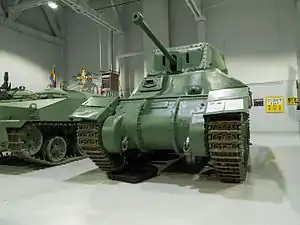
History
Canada originally named the association in 1910, however, Canada's first tank units were not raised until late in 1918. Initially these units were considered to be part of the Machine Gun Corps and the 1st Canadian Tank Battalion, 2nd Canadian Tank Battalion and the 3e Bataillon de chars d'assaut were all too late to join the fighting in the First World War. However, the 1st Canadian Tank Battalion was still training in Mark V tanks in the U.K. when the Canadian Tank Corps was finally authorized two days after the armistice. It seems like tanks were forgotten by the Cavalry after the war. Although, in the 1930s there were some small attempts at mechanization with motorcycles, experimental armoured cars and the purchase of a few tracked Carden-Loyd machine gun carriers for training. The first tanks since the First World War did not arrive until a few machine gun armed Vickers Mark VI light tanks appeared the year before Canada went to war with Germany again. From these modest beginnings the modern Canadian Armoured Corps began on 13 August 1940. Initially the Canadian Armoured forces brokered a deal to obtain scrap iron on behalf of the Canadian Government because isolationist laws prohibited the U.S. from foreign arm sales. At the time there were no tanks available to be acquired from Britain so the Canadians were desperate to get some. Therefore, 219 US M1917 tanks – a First World War design were obtained at scrap prices. They were sufficient to begin some tank training and familiarisation, but otherwise they were of very limited combat use. Events of the Second World War would thrust Canada into large scale tank production with thousands of Valentine, Ram, and Grizzly tanks and their armoured variants being produced. Canada would also go on to build modern armoured fighting vehicles that served during the Cold War, the War in Afghanistan and global peacekeeping operations.
Valentine Tank
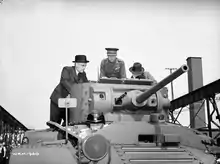
After the fall of France, it was decided the nascent Canadian armoured divisions would be equipped by tanks produced in Canada. To form the 1st Army Tank Brigade, Valentine tanks were ordered. This British design was to be built in Canada. Aside from the necessary adjustments to the design to incorporate local engineering standards and available components, the Canadian Valentines used a GMC engine. This engine, being an improvement over the original, was later applied to British production. Even before the loss of the majority of the United Kingdom's tank force in France in 1940 after Dunkirk, it was recognised that tank production in the UK at the start of the war was insufficient and capacity in the US was taken for British needs.[1] So it was necessary that if Canada was to equip with tanks they would have to be manufactured locally.[2] In June 1940 the Canadian Pacific Railway's Angus Shops in Montreal, as the only large firm with spare capacity, had received a contract to produce 300 partially fitted out Valentine tanks for the British; this was followed later with one for 488 complete tanks for Canada.[3] However the Valentine was an infantry tank and Canada required a cruiser tank for its recently formed armoured division. In the end 1,940 Valentines were produced by CPR most of which were supplied to the USSR. Although the Valentine used a number of American produced parts, its reliance on British components, difficulties in adapting its manufacture to North American methods, and other problems such as limitations to the availability of the right type of armour plate affected Valentine production. In practice, Canada never used most of the 1,400 Valentines they built as they were supplied under lend-lease to the Soviet Union.
Ram Tank
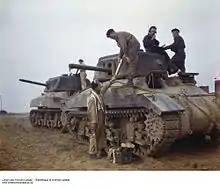
The Canadian Joint Committee on Tank Development concluded in September 1940 that its cruiser tank should be based on a US rather than a British design.[4] This would be quicker and allow it to use components already in production for the US design.[5] In early 1941 the 1st Tank Brigade was sent to Britain and equipped with the Matilda infantry tank. For the formation of two armoured divisions it was expected that 1,200 cavalry tanks were needed. The United Kingdom was not in a position to supply them, as it had shortfalls in supply for its own needs. This meant that Canada had to develop its own production. To this end a tank arsenal was set up under the management of a subsidiary of a US firm engaged in tank production. This Canadian indigenous tank design would become the standard armoured vehicle for the Canadian army. The result was the Ram cruiser tank, based on the chassis and running gear of the US M3 Lee; Rams were produced by the Montreal Locomotive Works (MLW) from 1941 to 1943.
Except for the Badger flame thrower tank conversion of the Ram tank and other variants that were in action in NW Europe, the Ram tank did not go to war with the Canadian Armoured Divisions. The decision was made to use the new Sherman tank as standard equipment. The Ram's main contribution to the war effort was to fully equip large armoured units formed in Canada and the U.K. with a modern tank it could use to conduct essential tactical training prior to the invasions in Italy and Normandy. The Ram was produced in numerous variants, the most notable being the Kangaroo Armoured Personnel Carrier.
Variants of the Ram Tank
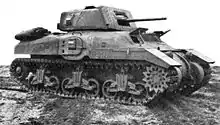
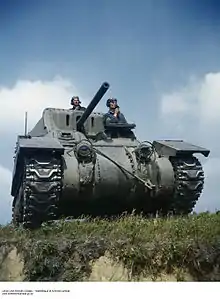
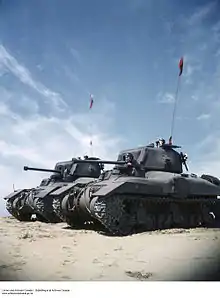
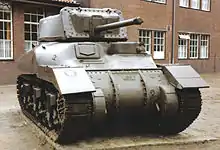
- Tank Cruiser, Ram Mk I
- Ordnance QF 2 pounder / 40mm gun (171 rounds).
- Tank Cruiser, Ram Mk II
- Early production: Mk III QF 6 pounder (57 mm) gun with 92 rounds.
- Late production: Mk V six-pounder. Auxiliary turret and sponson door removed. Browning .303 in (7.7 mm) machine gun fitted in ball mount.
- Badger
- A flamethrower equipped tank. The first Badgers were Ram Kangaroos with the Wasp II flamethrowing equipment (as used on the Universal Carrier) installed in place of the bow MG. Later models were turreted Rams with the equipment in place of the main gun.
- Ram Kangaroo
- Ram with turret removed to give an armoured personnel carrier capable of carrying 11 battle-ready troops as well as the two crew. See Kangaroo.
- Ram OP/Command (84)
- An armoured vehicle to function as a mobile observation posts for the Forward Observation Officers (FOO) of Sexton self-propelled gun units, based on Ram Mk II. The gun was replaced by a dummy, and two Wireless Set No. 19 radios were fitted with a No. 58 set. Crew of six. They were built from the last 84 Rams off the production line in 1943.[2]
- Ram GPO
- Like OP but with special equipment for "Gun Position Officers" of self-propelled artillery regiments. Had Tannoy loudspeakers mounted.
- Sexton "25-pdr, SP, Tracked"
- Self-propelled artillery vehicle armed with QF 25 pounder gun in open-topped superstructure.
- Ram Ammunition Carrier
- Also called "Wallaby", an armoured ammunition supply vehicle, converted as for the Kangaroo but used to carry 25-pdr ammunition for Sexton.
- Ram ARV Mk I
- Armoured recovery vehicle created by adding winch gear added to Ram Mark I .
- Ram ARV Mk II
- ARV based on Ram Mk II. Jibs and earth spade added, turret replaced by dummy.
Grizzly
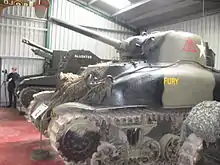
The M3 was succeeded by the superior M4 Sherman. The Allies agreed to standardise on the M4, and MLW began producing the Canadian version, the Grizzly tanks in August 1943.[6] The Grizzly's suspension used 17-tooth drive sprockets and CDP tracks. In comparison, the M4 used 13 tooth drive sprockets. The CDP track was lighter and simpler than the standard US tracks and did not require rubber, which was scarce since the Japanese advance into Southeast Asia. The Canadian Grizzly tank production halted when it became apparent US production would be sufficient. Instead, MLW produced the Sexton self-propelled gun Mk II. The Sexton Mk II used the Grizzly chassis, with the upper hull modified to carry the Commonwealth standard QF 25 pounder gun. The Sexton was the Commonwealth counterpart to the US M7 Priest. A small batch of Grizzly medium tank was fitted with an Ordnance QF 17-pounder for training but none saw action.[7]
Cougar
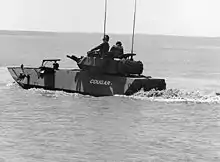
Starting with the introduction of the U.S.-designed and built Sherman tank, Canada began a tradition of acquiring U.S., British and then later German made armour to equip the Canadian Army. Often there were revisions to the original specification driven by Canadian requirements. It wasn't until the late 1970s that an armoured vehicle was fielded by Canadian Armoured Regiments that was developed and built in Canada. Although not a Main Battle Tank, the Cougar AVGP - manufactured at GM Diesel Division in London, ON (now part of General Dynamics Land Systems) was envisioned. The AVGP was the first Canadian built AFV in service since the Second World War. The amphibious Cougar was a direct Fire Support Vehicle (Wheeled) FSV(W) variant of the AVGP (Armoured Vehicle General Purpose). It was based on the Swiss MOWAG 6X6 Piranha hull with a 76 mm main gun mounted in a British FV101 Scorpion Tank turret. Cougars entered service in the late 1970s in Canadian based regular and reserve Armoured Regiments. They were intended as a quick air transportable fighting vehicles and used by the CAST Brigade for service in Norway and later with the 1st Canadian Division committed to NATO's CENTAG. They were too light to be effective against MBTs however the end of the Cold War meant they were used in stability operations in Bosnia and Somalia and relegated to training the tank crews in Canada that later received repatriated Leopard C1 tanks from the Canadian Forces in Germany that were disbanded in 1994.
Coyote
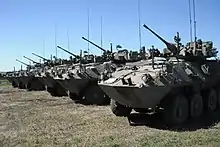
The experience gained by the Cougar and AVGP program evolved into the highly successful, made in Canada, LAV-25 and LAV III armoured vehicles that have been deployed by armies around the world. The Coyote Armoured Reconnaissance Vehicle is a Canadian produced eight-wheeled armoured reconnaissance vehicle based on and upgraded version of the LAV-25, 203 entered Canadian service by 1996.
Plan to transition to the Armoured Combat Vehicle
As originally conceived in the early 1990s, the Armoured Combat Vehicle (ACV) was intended to replace the AVGP Cougar for the types of missions that it had been called upon to carry out during Operations Other Than War (OOTW) in Somalia and Bosnia.[8] Such a purchase was seen as part of a two-tier equipping strategy - the wheeled 105mm-armed ACV and some other lighter-weight equipment for OOTW and a main battle tank (MBT) and related heavier equipment for warfighting.[9]
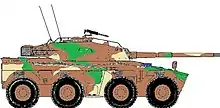
However, by the mid-1990s elements of the Canadian army were envisioning the ACV replacing both the AVGP Cougar and Canada's obsolescent Leopard 1 MBTs as part of a move to a medium-weight wheeled army.[10] In 2003, Canada announced that it would replace its Leopard 1s with lightweight Mobile Gun Systems.[11] This decision was made although the MGS met neither some of the key capabilities sought in the notional Canadian ACV nor the futuristic, high technology (and not-yet achieved) requirements for a future ACV that had been highlighted only the year before by the Commander of the Canadian Army to a Canadian Parliamentary committee.[12]
Canadian research-wargaming-based operational research studies[13] and other professional public commentators all argued against this move.[14] The biggest concerns were that the ACV's planned weak armour and firepower meant that it could not manoeuvre in the presence of a modern enemy and that it could only use ambush tactics against modern MBTs and AFVs,[15] becoming in effect a death trap if it tried, at all, to fulfil the MBT role. Operational research also looked at the benefits of giving the ACV a through-the-barrel (TBM) as well as the equivalent of 400mm of additional armour. The research found that such improvements gave the ACV MBT-like firepower but still left it unable to manoeuvre in the presence of a capable enemy.[16]
Leopard II
In September 2006, conventional fighting in the Panwayi district of Afghanistan in September 2006 led to a rethinking of the ACV plan.[17] A squadron of Leopard 1s was rushed out to Kandahar Province in Afghanistan and arrangements were made for the army to borrow modern Leopard 2 MBTs from Germany for deployment to Kandahar until Canada could buy used Netherlands' Leopard 2s to replace its Leopard 1s.[18] In 2007, Canada abandoned its plan to buy the Mobile Gun System.[19]
Canadian Tanks of the First and Second World War to present
- Mark V tank - WWI ended while the 1st Canadian Tank Battalion was still training in Mark V tanks in the U.K. Shortly after the war ended, the tanks were returned to the British.
- Carden Loyd tankette – 12 used by Canadian Armoured Fighting Vehicle School in a training role from 1931.
- Vickers Light Tank Mk VI - 12 delivered in 1938, Pre WWII machine gun equipped light tank (some retained for driver training in Canada early in WWII)
- M1917 - Acquired by Canada on an emergency basis early in WWII (used as a tank trainer in Canada)
- Valentine tank - First Canadian built tank (most sent to the Soviet Union under Lend Lease a small number remained in Canada for training crews)
- Matilda Infantry Tank Mark II - Acquired in small numbers from British stocks to train crews in the U.K. prior to the arrival of the Ram Tank from Canada (Did not see action with the RCAC)
- M3 Lee - Acquired in small numbers from British stocks to train crews in the U.K. prior to the arrival of the Ram Tank from Canada (Did not see action with the RCAC)
- Ram tank - Canadian indigenous tank design based on the M3 (superseded by the Sherman tank as standard equipment in the RCAC but the Badger variant did see action as a flame thrower tank in NW Europe) The Ram tanks main contribution to the war effort was to fully equip armoured units in Canada and the U.K. with a modern tank to conduct essential tactical training prior to re-equipping with Sherman tanks for the invasions in Italy and Normandy).
- Churchill tank - Issued to Canadian Tank brigades it saw action at Dieppe, Italy, Normandy and NW Europe.
- Honey light tank - Used as a Recce Tank throughout the WWII campaigns. The updated Stuart tank known as the M5 and some turretless versions were also used.
- Grizzly I cruiser - Canadian-built M4A1 Sherman tank with modifications (production in Canada halted when U.S. factories overwhelmingly produced enough Sherman tanks for the U.S. and its allies).
- Sherman M4A2 & M4A4 tank- U.S.-built, issued on a very large scale (known as Sherman III and Sherman V in Canadian service) The M4A4 became the standard medium tank in the Canadian Army during WWII, replacing the Ram tank, but these remained in Europe after the war ended while the diesel powered M4A2 Shermans were retained in Canada (some remained in Army Reserve service and were used for training during the post war years, alongside M4A2E8 Shermans, until 1970).
- Sherman Firefly - bolstered Canadian armoured formations giving them the firepower needed to defeat German Tiger and Panther tanks late in the Second World War. It was based on the US M4 Sherman but fitted with the powerful 3-inch (76.2 mm) calibre British 17-pounder anti-tank gun as its main weapon.
- M10 Tank Destroyer also mounting the British 17-pounder anti-tank gun (or M7 3-inch (76.2 mm) Gun as it was called by the Americans) in a rotating turret on a modified M4A2 Sherman tank chassis. The M10 was issued to Canadian Anti-Tank units in NW Europe.
- Staghound Armoured Car - Although the Canadian Army used various machine gun and cannon armed light armoured cars in WWII as scout cars, the Staghound Armoured car with a turret mounted 37 mm main gun was the only heavy armoured car employed by Armoured Car and Reconnaissance regiments in the NW Europe campaign. The Staghound's were deployed for flank security, protecting lines of communication and in the screening force where they fought in the recce role. Some Staghounds remained in Army Reserve service and were used for training during the post war years.
- Sherman M4A2E8 & M4A3E8 tank - 294 M4A2E8 tanks were purchased by the Canadian government in 1946 and another 20 M4A3E8 tanks acquired from US stocks already in Korea for Korean War service in 1951. Canadians fought these borrowed tanks with distinction in the Korean War and they were returned to the Americans in November 1954. These Shermans were equipped with the long barrelled 76mm High Velocity gun and the "E8" designation referred to the revised hull fitted with Horizontal Volute Spring Suspension (HVSS) giving a much better ride, hence the nickname "Easy Eight". The M4A3E8 Shermans were replaced by the Centurion Mk.3 tank in the Regular Force after 1952 but they lasted into the early 1970s with some Reserve Force units in Canada.
- M24 Chaffee light tank - 32 were ordered in 1947 for recce duties.
- Centurion Tank - Canada Initially ordered 274 Mk 3 Tanks, plus 9 Armoured Recovery Vehicles and 4 Bridge-layers and additional orders followed. Acquired for NATO use, most served with 4 CMBG in Germany and some served in Canada with units of the Royal Canadian Armoured Corps from 1952 to 1977. The Mk 5 (upgunned to 105 mm) were used later. Towards the end of their service the Mk 5 and Mk 11's were used as combat tanks and the earlier Mk 3 was retained as a training tank. From 1969 to 1970 the Canadian Army lists 77 tanks based in Germany (mostly Mk 5 and Mk 11's) and the remainder in Canada (60 at CFB Wainwright AB, 59 at CFSD Longpointe PQ, 46 at CFB Gagetown NB, 30 at CFB Borden, 29 at CFB Meaford ON, 27 at CFB Calgary AB, 12 at CFB Petawawa ON, 6 at RCEME School Kingston ON and 1 at the LETE Test Establishment Orleans, CFB Ottawa ON) for a total of 347 Tanks (including 120 Mk 5's, 3 Mk 5 Recovery tanks and some Mk 11's with IR and ranging guns fitted). Replaced by Leopard C1 MBT and to a limited extent, AVGP Cougars were intended (as a cost saving measure) to replace the earlier Marks of Centurions that had been used for the training role in Canada. Many of the tanks were sold to Israel which converted them to diesel. Some are still in use as variants.
- Ferret Armoured Car - 124 Ferret Armoured cars were operated by Canadian Armoured Recce units from 1954 to 1981. Canada purchased Mk1's but some Mk2's were also acquired from BAOR stocks in Germany. They were replaced by the Lynx with some retained for reserve training.
- Lynx reconnaissance vehicle - The Canadian Forces accepted 174 vehicles from 1968, replacing their Ferret armoured cars. Lynx was issued to the reconnaissance squadron of an armoured regiment (D Sqn). Consisting of three troops, each equipped with seven Lynxes—three two-vehicle patrols plus the troop leader's vehicle. In addition, nine Lynxes equipped the reconnaissance platoon of an infantry battalion's combat support company. The commander operates a M2HB from the M26 manually traversed heavy machine gun cupola from inside the vehicle. The rear-facing observer operates the radio and fires the pintle-mounted 7.62mm machine gun. In 1993 they were withdrawn from service and replaced by the Coyote.
- Cougar AVGP - manufactured at GM Diesel Division in London, ON (now part of General Dynamics Land Systems) the AVGP was the first Canadian built AFV in service since the Second World War. The amphibious Cougar was a direct Fire Support Vehicle (Wheeled) FSV(W) variant of the Armoured Vehicle General Purpose. It was based on the Swiss MOWAG 6X6 Piranha hull with a 76 mm main gun mounted in a British FV101 Scorpion Tank turret. Cougars entered service in the late 1970s in Canadian based regular and reserve Armoured Recce Regiments.
- Coyote Armoured Reconnaissance Vehicle - A Canadian produced eight-wheeled armoured reconnaissance vehicle based on the LAV-25, 203 in service by 1996.
- Leopard 1 Main Battle Tank
- Leopard C2 Main Battle Tank
- Leopard 2 Main Battle Tank
- TAPV Armoured Reconnaissance Vehicle. - Received 2016
See also
Notes and references
- Ellis and Chamberlain p3
- Ellis and Chamberlain
- Ellis & Chamberlain p5
- Cameron, L.R.Tank Production in Canada AHQ Report 38, Department of National Defence Directorate of History and Heritage (DHH), 27 July 1950
- Chamberlain & Ellis (1969) p172
- http://mailer.fsu.edu/~akirk/tanks/can/Canada.htm
- Skaarup, Harold (2011). "Ironsides": Canadian Armoured Fighting Vehicle Museums and Monuments. iUniverse.com. p. 78. ISBN 978-1462034642.
- Major Lee J. Hammond, Tank: The Canadian Army's Four-Letter Word, Army Doctrine and Training Bulletin (ADTB) Vol. 4, No. 4, l(Kingston, Ont: Canadian Government Publication, 2002), pg 79. (http://publications.gc.ca/collections/Collection/D12-9-4-4E.pdf). (Retrieved 2019-03-31).
- Major L.R. Mader, “The Come As You Want” War: Some Thoughts on Force Structuring in the Era of Discretionary Conflict, Canadian Army Journal (CAJ), Vol. 7, No. 1, (Kingston, Ont: Canadian Government Publications, 2004), pg 51. (http://publications.gc.ca/collections/Collection/D12-11-7-1E.pdf). (Retrieved 2019-03-31).
- Hammond, Tank, pg 74. (http://publications.gc.ca/collections/Collection/D12-9-4-4E.pdf). (Retrieved 2019-03-31).
- "Canada to replace tanks with Stryker Mobile Gun Systems". Military Procurement International. Switzerland: DAPSS. 13 (22). 15 November 2003. Retrieved 3 June 2015.
"ARCHIVED - Minister of National Defence Announces Acquisition of a Mobile Gun System". National Defence and the Canadian Armed Forces. Government of Canada. 6 November 2013. Retrieved 3 June 2015.
Storey, Ed (2012). "The Success of the Light Armoured Vehicle" (PDF). Canadian Military History Journal. Wilfrid Laurier University. Retrieved 3 June 2015. - He stated - in effect - that it would be a stealthy (and perhaps in time invisible) light armoured vehicle (LAV), probably wheeled, with the firepower and shock action of an M1A2 MBT, and with a protective system that would defeat ALL incoming projectiles (i.e. the system would be 100% reliable, 100% effective, and 100% available, and give 100% coverage of the vehicle's external surface). See Mader, Shifting Paradigms, pgs 42 and 43. (http://publications.gc.ca/collections/Collection/D12-9-6-2E.pdf). (Retrieved 2019-03-31).
- Operational Research Division (ORD) project reports (PR) Maj D.C. Wilkinson and M.K Ormrod, PR 9607 IRON NOBLE: Armoured Combat Vehicle Study, (Ottawa, Ont: Canadian Government Publications, 1996); M.K. Ormrod, P.R.S. Bender and Maj J.J.L.C. Noël de Tilly, PR 9817 QUARRÉ de FER: Analysis of the ACV in Warfighting Tasks, (Ottawa, Ont: Canadian Government Publications, 1998); M.K. Ormrod, P.R.S. Bender and Maj D.T. Davison, PR 9905 IRON RENAISSANCE: Evaluation of the LAV III Combat Team in Conventional War Operations, (Ottawa, Ont: Canadian Government Publications, 1999); Major J.A. Summerfield and Mr M.K. Ormrod, R 2003/01 Main Contingency Force Brigade Group Combat Capabilities Study (BRONZE ZIZKA), (Ottawa, Ont: Canadian Government Publications, 2003); Mr. M.K. Ormrod, Mr P.R.S. Bender and Major P. Hewitt, PR 2001/16 IRON XINETE: Land Force Battle Group Mobility Support Study, (Ottawa, Ont: Canadian Government Publications, 2001); and Major R.J. Round and Mr F.W.P. Cameron, PR 9708 BRONZE PIKE – LAV Recce Vehicle (COYOTE) Study, (Ottawa, Ont: Canadian Government Publications, 1997).
- See: Hammond, Tank, pgs 80-82. (http://publications.gc.ca/collections/Collection/D12-9-4-4E.pdf). (Retrieved 2019-03-31); Major L.R. Mader, Manoeuvrist Operations: Some Thoughts on Whether We Have Got It Right, ADTB Vol. 3, No. 4/Vol. 4, No. 1, (Kingston, Ont: Canadian Government Publications, 2001), pg 51. (http://publications.gc.ca/collections/Collection/D12-9-3-4E.pdf). (Retrieved 2019-03-31); Major L.R. Mader, Shifting Paradigms: Be Careful of the Grails You Consider Holy (Some Thoughts on the Army’s Future Force Structure), ADTB Vol. 6, No. 2, (Kingston, Ont: Canadian Government Publications, 2003), pg 47. (http://publications.gc.ca/collections/Collection/D12-9-6-2E.pdf). (Retrieved 2019-03-31); Major Richard Moreau, Concept for the Employment of the Cavalry Squadron, ADTB Vol. 2, No. 4,(Kingston, Ont: Canadian Government Publication, 1999), pgs 120 and 121. (http://publications.gc.ca/collections/Collection/D12-9-2-4E.pdf) (Retrieved 2019-04-04); and Captain Don Senft, Leopards in Kosovo: The Solution For An Armoured Combat Vehicle?, ADTB Vol.3, No. 1, (Kingston, Ont: Canadian Government Publication, 2000), pgs 58, 59, 61, and 62. (http://publications.gc.ca/collections/Collection/D12-9-3-1E.pdf). (Retrieved 2019-04-04).
- Mader, Manoeuvrist Operations, pg 51
- Mader, Manoeuvrist Operations, pg 51.
- Major-General (Ret'd) David Fraser and Brian Hanington, Operation Medusa - The Furious Battle That Saved Afghanistan from the Taliban, (Toronto, Ont: McClelland & Stewart, 2018); pgs 185-187.
- Canadian DND Backgrounder The Tank Replacement Project. (http://www.forces.gc.ca/en/news/article.page?doc=the-tank-replacement-project/hnps1uss) (Retrieved 2019-04-10) and Lee Windsor, David Charters, and Brent Wilson, Kandahar Tour – The Turning Point in Canada’s Afghan Mission, (Mississauga, Ont: John Wiley & Sons Canada, Ltd, 2008), pgs 62, 63, 65, 133, 160, 161, and 198. "Tanks for the Lesson: Leopards, too, for Canada". Defense Industry Daily. 18 June 2014. Retrieved 3 June 2015.
Addinall, Robert (2012). "The Long Engagement" (PDF). The Canadian Army Journal. Government of Canada. 14 (3). Archived from the original (PDF) on 20 November 2013. Retrieved 3 June 2015.
Landry, Eric (2013). "Something Old, Something New, and Something Borrowed" (PDF). Canadian Army Journal. Government of Canada. 15 (7). Retrieved 3 June 2015.
"Cost of battle tanks double initial estimate, O'Connor reveals". CBC. The Canadian Press. 18 May 2007. Retrieved 3 June 2015.
"Cdn. troops to get new tanks in Afghanistan". CTV News. 18 May 2012. Retrieved 3 June 2015. - Major Howard Mark Anthony, Close Combat Vehicle and Leopard 2 Main Battle Tank: Back in the Heavyweight Fight, Canadian Forces College, pg 13, Footnote 21, https://www.cfc.forces.gc.ca/259/290/298/286/anthony.pdf Accessed 2019-11-17
External links
| Wikimedia Commons has media related to Tanks of Canada. |
- http://mailer.fsu.edu/~akirk/tanks/can/Canada.htm
- http://www.wwiivehicles.com/canada/tank-medium/grizzly.asp
- http://www.militaryfactory.com/armor/detail.asp?armor_id=292
- http://www.junobeach.org/e/4/can-tac-arm-can-e.htm
